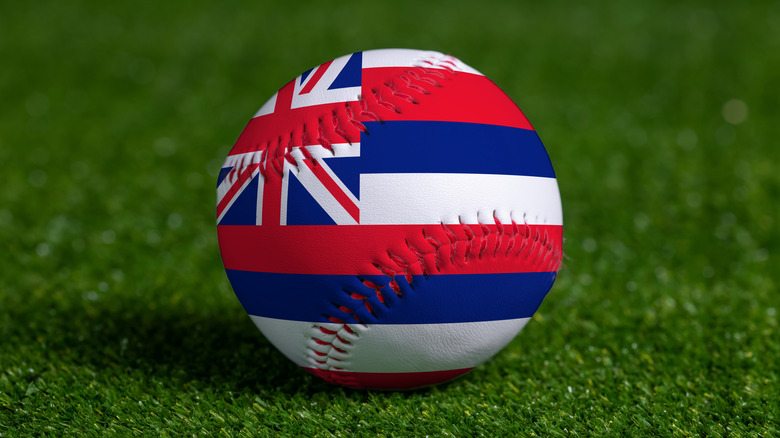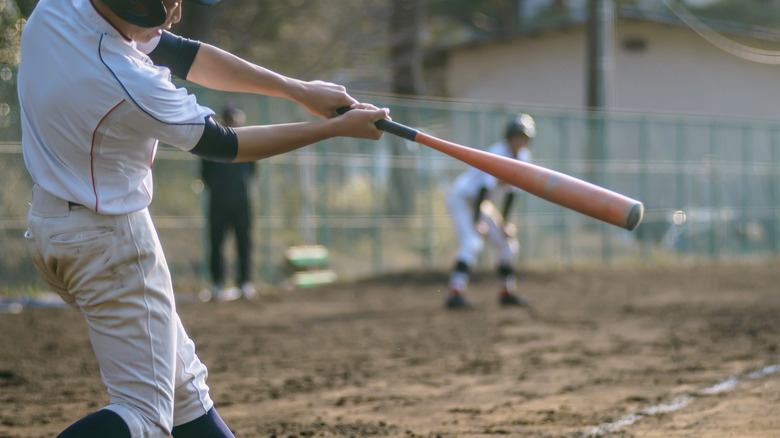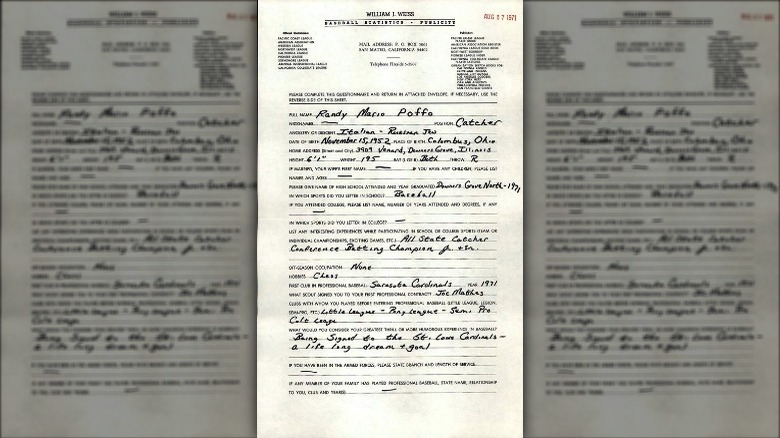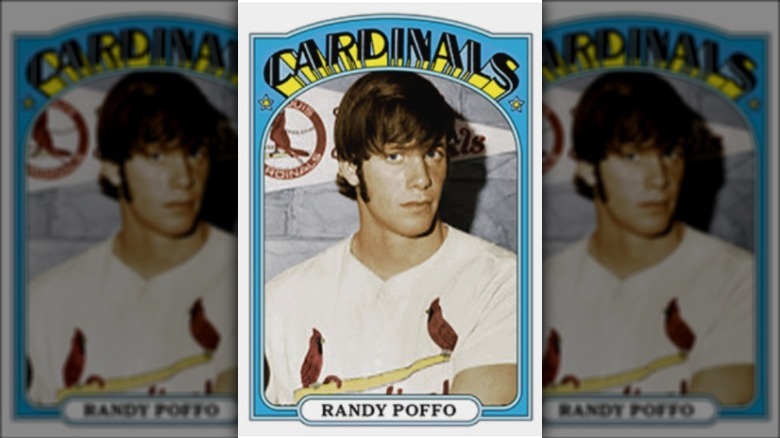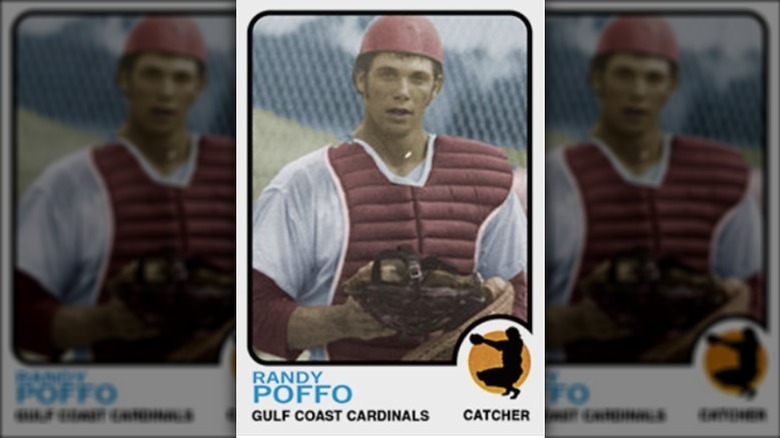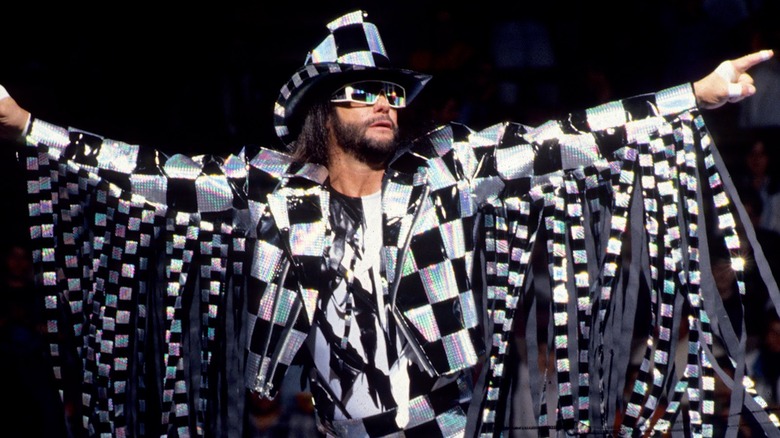The Truth About 'Macho Man' Randy Savage's Impressive Baseball Past
While some may hear the words "Macho Man" and think of the '70s Village People hit, any wrestling fan will in hear "Pomp and Circumstances" playing in their mind and will start to reminisce about one of the best showmen — and best all-around wrestlers — ever to step into a ring. Wrestling's gain, however, may have been another sport's loss. Even though Randy Savage came from a pro wrestling family (Angelo Poffo was his dad and Leapin' Lanny Poffo his brother), it seems he'd always had his heart set on a career in big league baseball.
While there are a few former MLB players in the WWE Hall of Fame — including Pete Rose, who was one of Savage's favorite players, and Bob Uecker, a man who'd also played catcher in the Cardinals organization a decade before Savage's minor league stint – the Macho Man is the only one who got there based on his wrestling skills alone. While Savage may have been bummed that he never made it to the big leagues, we can't help but be grateful that his injury-shortened baseball career led him to the squared circle where he'd become the "best there is ... past, present, and future!" (Ohhhhh yeahhhh!)
Randy Poffo was a baseball-obsessed kid
Randy Savage, even as a young boy, had baseball diamond dreams. Sports Illustrated says that by the age of seven or eight, he was carrying his glove everywhere he went. He could always be found in the backyard playing catch or taking swings at balls tossed by his brother Lanny, and Pro Wrestling Stories reveals that the brothers would also play pickup games in a nearby park. At the age of 10, Randy got his first taste of organized ball when his mom signed him up for Little League in his hometown of Downer's Grove, Illinois.
Even in the wintertime, Randy and Lanny didn't have to give up his practice time. His father, noticing how much his boys loved to play, arranged to have a winter-proof batting cage built in the family's backyard and even equipped it with a pitching machine. That cage, along with Randy's arm, must have gotten quite a workout during those long Illinois winters when there's not much else to do. While the Poffo boys also played football and basketball, it seems hockey may have been one of the few sports they never really got into. (Too bad, since Randy Savage on ice is something we'd have willingly paid big bucks to see.)
His father was very supportive of his baseball dreams
Before Angelo Poffo, Randy's father, became a wrestler, it seems that this Italian immigrant once also had hopes of making it big in America's pastime. As his obit in the Tampa Bay Times reveals, though, his playing days ended in college when he took a fastball to the old brainbox. While he carved out a nice career for himself as a midcard wrestler, he was all there for his son's baseball dreams.
Poffo senior may have been the one to plant those dreams. In fact, a Sports Illustrated article relates how he'd take his boys for regular visits to both Chicago ballparks, Wrigley Field and Comiskey Park (the latter was home to the White Sox before their 1991 move to the park now known as Guaranteed Rate Field). He also spent time coaching his son on how to play catcher, which was the position that he himself had played. Perhaps Poffo's own love for the sport was why, despite the fact that his younger son followed him into the wrestling business, he was behind his oldest 100% when it came to Randy's first career choice.
He got to skip school for a year to focus on baseball
When Randy Poffo was a sophomore in high school, his dad got an offer to go and wrestle in Hawaii for a year. This sounds like the kind of instance where most parents would say, "the kids better stay back in Illinois because of school." The Poffo family, however, weren't in the business of crushing dreams — what's more, as per Pro Wrestling Stories, Angelo felt that delaying the boys' graduations by a year would lessen their chances of being drafted to fight in Vietnam. During their sojourn in the Aloha State, Randy and Lanny were home schooled under the not-at-all-strict tutelage of their mother. What this really meant, according to Lanny, is that they'd knock out the odd report or two and then spend the rest of their time playing baseball.
For 11 months, the brothers Poffo played catch all day long in the Honolulu sunshine. Catch wasn't the only game they played, though. Randy, all of 16 years old, actually landed a semi-pro catching gig with a semi-pro outfit called Gouvea's Sausage Phillies. (The team is long done, but Gouvea's is still one of Hawaii's top Portuguese sausage purveyors.) As Lanny later remarked (via Sports Illustrated), "That time in Hawaii made Randy a different level player."
He was a high school all-star
While Randy may have returned from Honolulu a seasoned semi-pro, his athleticism had never been in dispute prior to his varsity playing days. In fact, Sports Illustrated relates how back in junior high he'd astounded his phys-ed teacher by doing over 1,000 sit-ups when the teacher had questioned whether any of the students could go up to 100. (That's what you get for challenging the son of the world record holder for that particular feat — in 1945, Angelo Poffo cranked our 6,033 situps in a row.)
During his last two years as a Downers Grove North High Trojan following that Hawaiian hiatus, Randy Poffo was an undeniable star. As a junior, he batted .500, something that no doubt helped his team to win their conference title. As a senior, Randy was batting .525 and his team were conference champions once more. In both years, Pro Wrestling Stories says he was voted team MVP and was also chosen to play on Illinois' All-State Team.
He failed to get drafted out of high school
Despite Randy's outstanding high school baseball career, he was out of luck when it came to catching the eye of major league scouts. A few of them did turn out to watch him play on one occasion, but he was ill at the time (running a 102-degree fever, no less) and turned in a less-than-stellar performance. Nevertheless, he had high hopes on draft day ... hopes that were promptly dashed.
Over the several June days that it took to complete the 1971 draft, 794 players were selected, among them such later-to-be-legendary names as George Brett, Jim Rice, and Mike Schmidt. Not a single player by the name of Poffo, though. As Lanny later described this major disappointment (via Sports Illustrated), "That was the darkest of dark times for us ... Randy was ignored. Completely ignored. I assure you, he never forgot that feeling." Future Macho Man that he was, though, he did not take the pain lying down.
He was the only one selected from a Cardinals open tryout
To give credit where it is due, the person who may be most responsible for not letting Randy's baseball dreams die on draft day was his father. The very next day, the Cardinals were having an open tryout, so Angelo drove his son nearly 300 miles to St. Louis and insisted he give it his best shot. Well, Randy's best, on that occasion, was good enough for the Redbirds. His first at-bat scored a ground-rule double, and apparently that was all it took.
Some 300 hopefuls auditioned for the team that day, and the only one to be signed was Randall Mario Poffo. For $500 a month, he would get his shot with their rookie league in Tampa. Despite the fact that Randy wasn't offered a signing bonus, Lanny would later tell Sports Illustrated, he was nonetheless "elated ... It wasn't about the money. It was so much bigger than that." Randy himself must have felt a sense of vindication, as in an interview with the Downers Grove Reporter (via Pro Wrestling Stories), he shared that the Cards "were really surprised I wasn't drafted ... They felt I had unlimited potential." Despite his having grown up a Cubs fan, he was nevertheless pragmatic enough to pledge immediate allegiance to his new franchise when filling out their publicity form, as he claimed that playing for the Cardinals was "a life long dream + goal."
He played for four different teams and two franchises
Randy Poffo began his playing days with the Gulf Coast League Cardinals and would return to that same team the following year, as Baseball Reference shows. 1973 saw Randy with the Gulf Coast League Red Birds, also a Cardinals affiliate, but midway through the season a hot streak that saw him batting .344 earned him a promotion to the Orangeburg Cardinals of the Western Carolinas League. Although a step up from the GCL, this team was still at the single-A level.
It was with the Orangeburg team that Sports Illustrated says Randy suffered a season-ending injury when he crashed into another player at home plate. The Cardinals organization let him go for good shortly thereafter, but he did get one more chance in 1974 when the Cincinnati Reds signed him to their Florida State League Tampa Tarpons. While his last year in baseball was not an outstanding one, Randy would at least have the chance to play on the same team that had once served as a training ground for both of his idols, Johnny Bench and Pete Rose. What's more, during his time as a Tarpon he first met Lynn Payne, the woman who would later (much, much later) become his wife.
He switched off between catching and playing the outfield
Just like his father before him, the young Randy Poffo would don the infamous "tools of ignorance," these being (as per MLB.com) the catcher's mask, chest protector, and shin guards. Under his father's tutelage, he learned plate blocking, game calling, and all the other skills a good catcher needs, and he also picked up a few tricks from watching the great Johnny Bench. (Despite Randy's being a devout Cubs fan, Pro Wrestling Stories says his favorite players were Bench and Pete Rose, both of whom played for the rival Reds.)
Despite Randy's having played catcher since his Little League days and on through high school, his Baseball Reference stats show that he was switched to playing outfield during his first season in the minors in 1971. The next season, he'd add first base to his resume. Throughout the rest of his four seasons in the minors, the future Macho Man would primarily split his time between catching and playing the outfield, although he would have one more stint at first base in 1974.
He came up with a training exercise that was still in use 40 years later
One of Randy's teammates on the 1971 GCL Cardinals was Larry Herndon, a 17-year-old from Memphis, Tennessee. Herndon, interviewed in later years by ESPN, had nothing but praise for his fellow minor-leaguer, saying "I have memories of him as a great teammate and a great man ... he really cared a lot about others ... [and] was always having fun." Herndon also recalled a training exercise Randy used that involved hanging up a car tire and swinging at it with a bat. This drill was meant to give him stronger hands and also to make sure he was moving his legs as he swung.
Well, Randy may be gone, but his baseball drill lives on. Herndon, who played in the majors for 14 years and spent six more years as a hitting coach for the Detroit Tigers, wound up back in class-A ball as the hitting instructor for the Florida State League Lakeland Tigers. One of the drills he's used with his young hitters has been Randy's old trick of swinging at a hanging tire.
He might never have made it to the big leagues
According to Yahoo! Finance, only about 10% of all minor leaguers ever make it to the bigs, and the fact that Randy hadn't even been selected in the draft meant that he pretty much had the deck stacked against him from the get-go. Plus, there was that almost career-ending injury he sustained while playing for the Orangeburg Cardinals, a separated shoulder that required him to switch over to throw from the opposite side. Randy, a natural right hander, was no switch hitter, but he'd learned to throw left-handed in high school. As he explained to a friend at the time (via SB Nation), "a coach might want me to pitch, but I don't wanna burn out my arm. So I'll learn to do it lefty, and I'll save my right for the important things."
Despite Randy's willingness to give baseball his all, he had a few hurdles he was never able to overcome. For one thing, he was said to be "slow as mud." For another, his throwing, while powerful, wasn't terribly accurate. As he himself admitted (per Pro Wrestling Stories), "I had kind of a scatter arm. My throws to second would tail to the outfield, sometimes right field." Mike Moore, the Tampa Tarpons GM who would later serve as head honcho for all of Minor League baseball, summed up Randy's baseball potential by saying "Honestly, he didn't have the talent to go any farther."
Then again, his playing abilities might have been underestimated
Even though Randy's last manager may not have thought he had what it took to make it above the single-A level, this assessment was based on the post-injury player. Had Randy not had that home plate collision in 1973, could he have overcome the odds and been one of the few non-draftees to get the MLB callup? Deadspin, calling upon the mystical powers of sabermetrics, analyzed his career stats. We'll spare you the numbers and acronyms, but it seems he may have actually been one of the best hitters on the teams he played for, and was near the top league-wide, as well. When you consider how many other players in those same organizations eventually got the call-up, it makes you wonder.
Whether or not Randy would have ever suited up in Cincinnati Reds colors, he's nevertheless been memorialized in a display at the team's Hall of Fame and Museum. It includes a brief recap of his 1974 season with the team's minor league affiliate along with a custom-made baseball card. The customization was no doubt necessary because, as Sports Cards Rock notes, there are very few Randy Poffo cards out there and most (if not all) have been created by fans rather than being official team merch. Still, this portrait of a young Randy in a team uni — odd though it is to see him without wild colors and fringe — reminds us of what might have been.
He might have earned the Macho Man moniker during his playing days
There are several different stories about how Randy Savage came to be known as "Macho Man." Perhaps the most popular story, and the one Savage himself told IGN Sports in an interview, has the name coming from a story his mom read in Reader's Digest about how it was going to be "the next hot term." (His mom's obituary, however, implies that the article came out after the Village People song.)
Pro Wrestling Stories tells another tale. They say Randy, when playing for the Tarpons, was hit in the head with a ball thrown by the Winter Haven Red Sox pitcher. The proverbial bench-clearing brawl ensued, with Randy leading the charge. As he remembered it later, "Next day in the paper, some writer gets on me, says I was acting like some macho man. I liked that, and it became part of my name." It seems the fans picked up on the new nickname, too, holding up a banner in the outfield with the words "Hit it here, Macho Man." "I kind of dug that," Randy said, adding "It was perfect for me." Truer words ...
He started wrestling on the sly while still playing ball
While Randy may have turned to wrestling full-time once his playing days were over, he already had a foot in the ring a year or two prior to this. During his time with the Orangeburg Cardinals, his teammate Tito Landrum recalled (via Pro Wrestling Stories) "I can remember him setting up a ring in the locker room and wrestling with the guys. He told us he was going to be a wrestler someday."
Someday wasn't all that far off, as Randy would start wrestling shows in Florida during the offseason. He didn't want the baseball teams to catch wind of his moonlighting, so he wore a mask and adopted a superhero-type gimmick by calling himself "the Spider." Gerald Brisco, who saw him in a match at the old Fort Myers Armory sometime in 1974 or thereabouts, told The Miami News his first impression of the young wrestler. "He had good arms," Brisco recalled, adding "but he was small. He had to keep his weight around 175 pounds because of baseball, and that's pretty little for the ring." He went on to say, though, that "The main thing I remember is that he had a cocky attitude once he crawled through the ropes," one that would stand him in good for decades to come.
He took the end of his baseball career pretty hard
Even though Randy was already wrestling prior to his last season behind the plate (or in the outfield), he was determined to keep his baseball dreams alive for as long as he could. After the Tampa Tarpons released him, he launched a letter-writing campaign (this was long before the email era) and was eventually given a shot with the Chicago White Sox. As the Sox' farm director C.V. Davis told the Sarasota Herald-Tribune (via Pro Wrestling Stories) "I have to say we were impressed by his ambition and determination."
Despite his hard work, Randy failed to make the final cut once spring training was over, so he began a rapid-fire journey through all five stages of grief. "When they walked up and took my uniform out of my locker, I couldn't believe it," he said, thus entering the denial phase. This was soon followed by both anger and bargaining: "It got me pretty worked up," he said, adding "finally, I told 'em if I couldn't play baseball, maybe no one else would either. I told them I just might have to burn down the clubhouse and grandstands." This was followed by some more anger (and possibly depression) as he smashed all his bats after walking out the door. Finally, however, Randy reached the acceptance stage as he began the wrestling career that would see him achieve immortality in a far more flamboyant way than originally envisioned.



